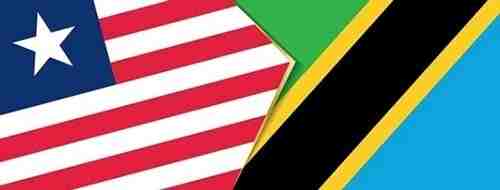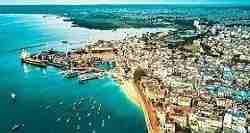2. Zanzibar Beaches and Water Activities | 🦁 Top Safari Destinations in Tanzania
Zanzibar boasts stunning white-sand beaches with turquoise waters, ideal for relaxation and various water sports.
- Northern Beaches (Nungwi, Kendwa): Known for their vibrant atmosphere, clear waters, and lively nightlife. Excellent for swimming, sunbathing, snorkeling, diving, and boat trips. Kendwa beach is also famous for its full moon parties.
- Eastern Beaches (Paje, Jambiani): Offer a more tranquil and secluded escape, popular for kite surfing, swimming, and exploring seaweed farms.
- Southern Beaches (Kizimkazi): Known for dolphin spotting tours.
- Mnemba Atoll: A protected marine conservation area, considered one of the best spots for snorkeling and scuba diving due to its vibrant coral reefs and diverse marine life (including turtles, lionfish, moray eels, and stingrays).
- Dhow Cruises: Enjoy traditional wooden sailboat cruises, especially popular for sunset trips, offering picturesque views and sometimes including stops at scenic islands or fishing villages.
- Other water sports: Parasailing, jet skiing, stand-up paddleboarding, and deep-sea fishing are also available.
Tanzania is famous for some of the best wildlife areas on Earth, including the iconic Serengeti and Ngorongoro Crater. Here’s an overview of the most popular parks and reserves: Safari Destinations in Tanzania
3. Zanzibar Nature and Wildlife:
- Jozani Forest National Park: Home to the endemic Zanzibar red colobus monkey. Visitors can take guided trails through the forest and explore mangrove boardwalks.
- Prison Island (Changuu Island): A short boat ride from Stone Town, famous for its sanctuary of Aldabra giant tortoises, some of which are over 100 years old. The island also has remnants of its past as a prison and quarantine station.
- Zanzibar Butterfly Centre: A tropical garden showcasing indigenous butterfly species.
- Cheetah's Rock: An animal rescue and conservation center offering unique interactions with various wild animals.
- Kuza Cave (Jambiani): A natural freshwater pool within a cave, significant for its cultural and historical importance to locals.
4. Zanzibar Culinary Experiences:
- Spice Tours: Immerse yourself in the island's nickname, "Spice Islands," by visiting a spice farm. Learn about the cultivation of cloves, nutmeg, cinnamon, vanilla, and other exotic spices, and enjoy tasting fresh produce.
- The Rock Restaurant: A unique dining experience on a rock in the Indian Ocean, offering exquisite seafood and stunning views.
- Street Food: Explore the vibrant street food scene, especially in Stone Town's Forodhani Gardens, for local delicacies like Zanzibar pizza and fresh seafood skewers.
Best Time to Visit Zanzibar
The best time to visit Zanzibar is during its dry seasons:
- July to September: This is a very popular period with pleasant weather, cooler temperatures, and minimal rainfall.
- January to February: Also a great time with hot and sunny days, and clear seas, making it excellent for diving and snorkeling.
- Avoid the "long rains" from April to May, as it can be very wet. The "short rains" in November and December bring brief downpours followed by sunshine, and fewer crowds.
Zanzibar Tourism Statistics and Trends
Zanzibar's tourism sector has shown significant growth and resilience
- In 2023, Zanzibar welcomed over 1 million visitors, a substantial increase from previous years, with tourism contributing significantly to the island's GDP (around 27% in 2022).
- The upward trend continued into 2024, with 736,755 arrivals, a 15.4% increase from 2023.
- Europe consistently remains the dominant source market, accounting for a large majority of visitors (e.g., 71.6% in 2024). Italy, Germany, France, and Poland are among the top contributing countries.
- Emerging markets from Asia (e.g., India, China) and other African countries are also showing promising growth.
- The vast majority of tourists (over 95%) visit for holiday purposes.
- Most visitors arrive by air (around 88%), with the remainder by sea.
- The average intended length of stay is typically around 7-8 days.
The growth in tourism has also prompted discussions about ensuring that visitors' spending benefits the local economy beyond just hotels, by investing in local attractions and businesses. Zanzibar is actively working on strategic marketing, improving air connectivity, and diversifying its source markets to sustain this growth.
🌿 1️⃣ Serengeti National Park
Serengeti National Park Highlights: The undisputed crown jewel of Tanzanian safaris. It's famous for the Great Wildebeest Migration, where millions of wildebeest, zebras, and gazelles traverse the plains in search of fresh grazing, often facing perilous river crossings (especially the Mara River crossing between July and October).
✅ Why go Serengeti National Park:
- The Great Wildebeest Migration (millions of animals crossing the plains)
- Huge herds of zebras, antelopes, buffalo
- Big cats: lions, leopards, cheetahs
- Endless golden savannah landscapes
- Serengeti National Park Famous for: The Great Migration—over 1.5 million wildebeest and zebras crossing the plains.
- Serengeti National Park Wildlife: Exceptional year-round wildlife viewing, including the Big Five (lion, leopard, elephant, rhino, buffalo), cheetahs, hyenas, and a vast array of plains game. It's particularly known for its high density of predators.
- 🎯 Best time to Visit Serengeti National Park: Depends on where the Migration is, but generally dry season (June-October) for general game viewing. January-February for calving season in the southern Serengeti.
- Landscape: Vast, endless plains, acacia woodlands, and rocky outcrops (kopjes).
🦏 2️⃣ Ngorongoro Crater
Ngorongoro Crater Highlights: A UNESCO World Heritage Site and often called "Africa's Eden." The Ngorongoro Crater is the world's largest intact volcanic caldera, forming a natural enclosure with an incredibly high density of wildlife. It's one of the best places to see the Big Five in a single day, including a relatively strong population of the endangered black rhino.
✅ Why go Ngorongoro Crater:
- UNESCO World Heritage Site
- The world’s largest intact volcanic caldera
- Ngorongoro Crater Wildlife: Almost all African plains animals, including lions, elephants, buffalo, hippos, wildebeest, zebras, and a wide variety of birds.
- Stunning views from the crater rim
- 🎯 Best time to visit Ngorongoro Crater: Year-round (mild climate), but drier months (June–October) are best for wildlife visibility.
- Landscape: Lush grasslands, swamps, and forests within the crater, surrounded by the dramatic caldera walls.
🐘 3️⃣ Tarangire National Park
✅ Why go to Tarangire National Park:
- Tarangire National Park Highlights: Famous for its enormous elephant herds and iconic baobab trees. During the dry season, the Tarangire River becomes the primary water source, attracting a massive concentration of wildlife.
- Tarangire National Park Wildlife: Large elephant populations, baobabs (trees), impalas, eland, wildebeest, zebras, giraffes, and a good variety of predators. It's also a birdwatcher's paradise with over 500 species.
- Giant baobab trees
- Excellent birdwatching (500+ species)
- Fewer tourists than Serengeti
- 🎯 Best time to visit Tarangire National Park: June–October (dry season—animals gather at the river)
- Tarangire National Park Landscape: Varied, with acacia woodlands, riverine forests, vast swamps, and open grasslands dotted with majestic baobab trees.
🦒 4️⃣ Lake Manyara National Park
✅ Why go to Lake Manyara National Park:
- Lake Manyara National Park Highlights: Known for its diverse habitats, which include a large soda lake (often teeming with flamingos and other birds), groundwater forests, and open grasslands. It's particularly famous for its tree-climbing lions, a rare behavior found in only a few locations.
- Lake Manyara National Park Wildlife: Tree-climbing lions, elephants, buffalo, hippos, giraffes, baboons, and a phenomenal array of birdlife (over 400 species).
- Tree-climbing lions
- Big flocks of flamingos
- Hippos and baboons
- Dramatic scenery with Rift Valley escarpment backdrop
- 🎯 Best time to visit Lake Manyara National Park: June–October (dry) or November–February (lush scenery)
- Landscape:
🐆 5️⃣ Selous Game Reserve (Now called Nyerere National Park)
✅ Why go to Nyerere National Park:
- Nyerere National Park Highlights: Africa's largest national park (upgraded in 2019 from a game reserve) and a UNESCO World Heritage Site. It's known for its immense size, diverse landscapes, and the mighty Rufiji River, which offers unique boat safaris.
- Largest protected area in Africa
- Fewer crowds—more remote and wild
- Boat safaris on Rufiji River
- Big populations of wild dogs, elephants, crocodiles
- Nyerere National Park Wildlife:Home to significant populations of elephants, hippos, crocodiles, and a good number of African wild dogs (a highly endangered species). Lions, leopards, and various antelope are also present.
- Nyerere National Park Activities: Game drives, walking safaris, and excellent boat safaris on the Rufiji River, providing a different perspective on wildlife.
- 🎯 Best time to visit Nyerere National Park: Dry season (June-October) when animals congregate along the river and water sources.
🦓 6️⃣ Ruaha National Park
✅ Why go to Ruaha National Park:
- Ruaha National Park Highlights: Tanzania's largest national park. It's a truly wild and remote destination, offering a rugged beauty and a feeling of genuine wilderness. It's known for its impressive concentration of predators, especially lions and wild dogs.
- Ruaha National Park Wildlife: Large prides of lions, good numbers of cheetahs and leopards, wild dogs, elephants, greater and lesser kudu, sable, roan antelope, and many more. The Great Ruaha River is a lifeline for wildlife during the dry season.
- Tanzania’s largest national park
- Remote, authentic wilderness experience
- High density of lions and elephants
- Less tourist traffic
- 🎯 Best time to visit Ruaha National Park: Dry season (June-October) for concentrated game viewing along the riverbeds.
- Ruaha National Park Landscape: Mopane woodlands, baobab trees, open plains, and the dramatic Ruaha River.
🏞️ 7️⃣ Arusha National Park
✅ Why go to Arusha National Park:
- Arusha National Park Highlights: Often a starting or ending point for Northern Circuit safaris or Kilimanjaro climbs. It's a smaller park but offers incredibly diverse landscapes, including Mount Meru, Ngurdoto Crater, and the Momella Lakes.
- Arusha National Park Wildlife: Known for giraffes, zebras, buffalo, warthogs, various antelope species, and black-and-white colobus monkeys. While no lions or rhinos are present, leopards are occasionally seen.
- Arusha National Park Activities: Game drives, walking safaris, canoeing on the Momella Lakes, and climbing Mount Meru.
- Great for short safaris (close to Arusha town)
- Mount Meru backdrop
- Giraffes, colobus monkeys, flamingos on Momella Lakes
- Canoeing and hiking options
- 🎯 Best time to visit Arusha National Park: ear-round, but drier months offer clearer views of Kilimanjaro and Meru.
🦓 8️⃣ Mikumi National Park
✅ Why go to Mikumi National Park:
- Easy to access from Dar es Salaam
- Good for quick safaris
- Lions, buffalo, giraffes, zebras
- Less tourist traffic
- 🎯 Best time to visit Mikumi National Park: June–October
- Landscape: Vast, endless plains, acacia woodlands, and rocky outcrops (kopjes).
9. Mahale Mountains & Gombe Stream
- 🐵 Primate Paradise
- Mahale Mountains National Park Highlights: Located on the shores of Lake Tanganyika, this park is renowned for its
- Mahale Mountains National Park Chimpanzee trekking: It's one of the best places in Africa to see wild chimpanzees.
- Best Time to visit Mahale Mountains National Park: Dry season (May-October) for easier trekking, as chimps are often closer to the lake shore.
- Mahale Mountains National Park Activities: Chimpanzee trekking is the main draw, but also boating and swimming in Lake Tanganyika.
- Mahale Mountains National Park Access: Requires light aircraft and boat transfers due to its remote location.
📍 Quick Reference Map
- Northern Circuit (most popular): Serengeti, Ngorongoro, Tarangire, Manyara.
- Southern Circuit (wild & remote): Ruaha, Nyerere/Selous.
- Western Circuit (primates): Mahale, Gombe.
✨ Which Should You Choose?
- ✅ First-Timers: Serengeti + Ngorongoro (iconic, easy logistics).
- ✅ Families & Short Trips: Tarangire + Manyara + Ngorongoro (close together).
- ✅ Off-the-Beaten-Track: Ruaha or Selous.
- ✅ Primate Lovers: Mahale or Gombe.
Most travelers combine several parks in the Northern Circuit: Serengeti + Ngorongoro + Tarangire + Lake Manyara
Choosing Your Top Safari Destinations in Tanzania
- First-time safari-goer/classic big game: Northern Circuit (Serengeti, Ngorongoro, Tarangire, Manyara) is ideal.
- Experienced safari-goer/seeking fewer crowds/unique activities: Southern Circuit (Nyerere, Ruaha) offers a different, more exclusive feel.
- Primate enthusiasts/adventure seekers: Western Circuit (Mahale, Gombe) for chimpanzee trekking.


 Visa Zanzibar Support
Visa Zanzibar Support
